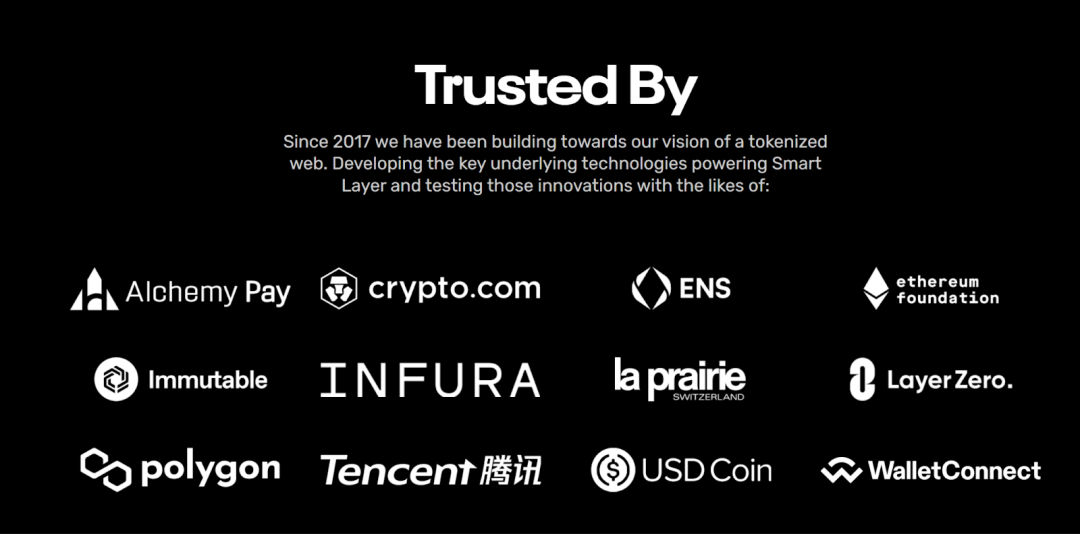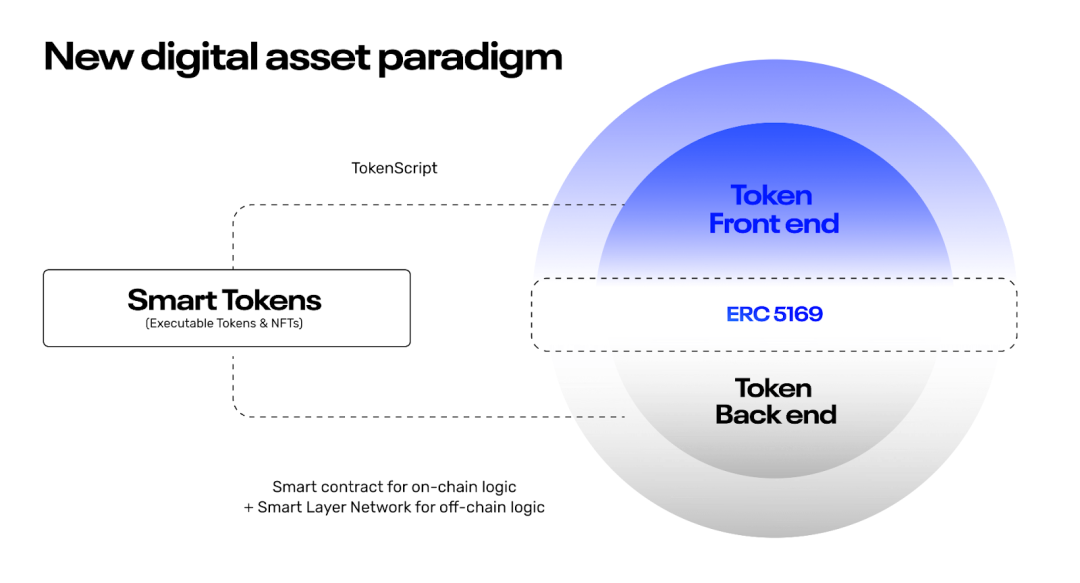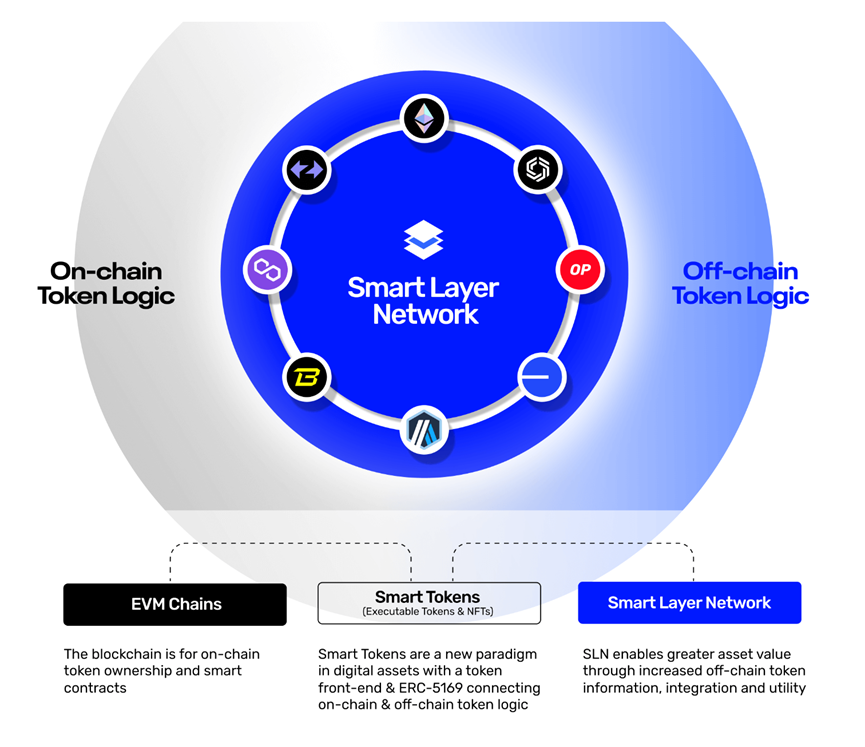Smart Layer: Middleware that connects Web3 and public chains
Author: Biteye Core Contributor Fishery
Editor: Biteye Core Contributor Crush
Community: @BiteyeCN
The relationship between public chains and Web3 has always been ambiguous. The user bases of both are highly overlapping, yet the business logic of most projects operates independently, ultimately relying on the project's token to link public chains and Web3 together.
Literally, it is easy to understand that Web3 is an upgraded version of Web2, seen as the next phase of the internet, aiming to create a decentralized network environment where users control their own data, identity, and transactions, rather than relying on centralized entities or platforms. Public chain technology is one of the key infrastructures to realize the Web3 vision.
To achieve a decentralized, secure, and user-driven Web3 internet, the technologies used must support these characteristics. Public chains provide a secure, transparent, and tamper-proof method of data recording, making it possible to exchange value, execute contracts, and store data without a central authority. Therefore, public chains are a key technology on the road to realizing the Web3 vision.
However, due to the current limitations of public chain technology in terms of performance and functionality, many Web3 projects have to compromise by using some centralized technologies in practical applications.
For example, projects may choose to use centralized servers to handle some computation-intensive tasks or store large amounts of data, only processing core value transfer functions through the public chain. While this compromise improves efficiency and functionality to some extent, it also weakens the degree of decentralization.
To truly realize the Web3 vision, further innovation on the basis of public chain technology is needed.
Smart Layer is an innovative infrastructure that can solve the above problems. It serves as middleware for public chains and Web3 applications, inheriting the security of public chains while executing complex Web3 business logic, making it a completely new concept.
01
Introduction to Smart Layer
Smart Token Labs, previously known as TokenScript, is an open-source middleware for programmable smart tokens and Web3 applications, enabling a smooth transition of existing Web2 businesses to Web3.
Smart Layer is an ecosystem that provides a programmable service network for public chains, ushering in the era of smart token execution, making complex interactions with various systems and tokens possible.
For token issuers, this platform not only allows them to create and manage programmable smart tokens but also provides a middleware solution for Web3 services, greatly simplifying the complex tasks of integrating web services with token functionalities. Smart Layer is the missing layer needed to unlock mainstream tokenization use cases.
Smart Token Labs has a solid background, with a long development cycle. The team raised $6 million in initial funding from investors such as Mark Cuban, Crypto.com, Framework Ventures, and Mechanism Capital in July 2021.
In September 2022, led by well-known Chinese investor Liang Xinjun, along with participation from HashGlobal, Bodl, and Fenbushi Capital, the project secured another $6 million in funding at a valuation four times that of the previous round, indicating strong support and confidence from professional investors in the sector.
Earlier this year, Smart Layer published a retrospective on its development, stating that it has completed support for EVM public chains and can manage token logic that is not stored on-chain.
Additionally, the project launched the eye-catching Smart Cat xNFT game, attracting significant interest from players. The team also proposed the ERC-5169 standard, adding a new dimension to token interoperability and functionality.
Meanwhile, Smart Layer successfully launched the Loyalty+ program through close cooperation with InsomniaLabs, aimed at strengthening the loyalty connection between brands and users through public chain technology. The project has over 50 partners, including Polygon, LayerZero, and Alchemy, demonstrating its broad application potential in the industry.

In terms of operations, Smart Layer collaborated with world-renowned cricket star Glenn Maxwell to launch a global fan engagement program using Smart Layer's proof-based executable NFTs.
As middleware, Smart Layer is highly significant. It not only simplifies the complexity of transitioning traditional Web2 businesses to Web3 from a service perspective but also provides development teams with a flexible set of tools, making it easier for them to develop and deploy decentralized applications.
At the same time, Smart Layer effectively bridges the gap between public chains and Web3, providing users with a more secure, transparent, and decentralized user experience. It addresses the limitations present in the current public chain technology environment while ensuring broader application possibilities.
Most importantly, Smart Layer announced that it will launch an airdrop program this year (2024)! According to existing information, its SLN token will serve as a service incentive point for the Smart Layer network, ensuring the decentralization and smooth operation of the entire network.
02
Technical Details
From a macro perspective, Smart Layer's technology consists of three parts: public chain, Anchoring Nodes, and Service Nodes. From the user's perspective, the innovative technical structure of Smart Layer can be divided into two main blocks:
Smart Token ERC-5169: An innovative token standard issued on EVM public chains that inherits traditional token functionalities while adding interactivity.
Smart Layer Network: A network layer that enables token interactivity, serving as a decentralized network infrastructure distinct from public chains.
Smart Tokens
Smart Token Labs proposed the Ethereum standard ERC-5169 in May 2022, aiming to enhance token functionality and interoperability by introducing the scriptURI() function.
This proposal allows tokens to associate with executable scripts, enabling tokens to not only carry value but also execute complex logic and interact with various systems. From an industry development perspective, ERC-5169 is a key innovation in realizing the Web3 vision, allowing tokens to become intelligent tools that connect users, data, and services.
Currently, ERC-5169 has attracted widespread attention from the community and has gained a certain level of recognition. By allowing tokens to directly associate with external scripts, it opens up new dimensions for token usage and functionality, and it is believed that one day ERC-5169 will be included in the official standards of the Ethereum community.

From a technical implementation perspective, the core of the ERC-5169 standard is the introduction of the scriptURI() function. Through this function, token contracts can point to an externally stored script address, which can contain any form of logic, from simple information display to complex application logic.
This means that developers can add additional functionalities to tokens, such as automated trading, conditional execution, data retrieval, etc., greatly expanding the application scenarios and potential of tokens.
Developers can use the scriptURI() function to specify the location of the external script associated with the token, which is usually a URL pointing to a script file stored in a distributed file system (such as IPFS) or other reliable storage services.

ERC-5169 not only creates feature-rich smart tokens but also promotes innovation in decentralized applications (DApps) and Web3 services, providing users with a richer, more flexible, and secure digital asset experience.
Smart Layer Network
In addition to the new token standard, the core technology of Smart Layer provides a decentralized service layer network, enabling EVM-based tokens to achieve more complex functionalities and services.
The Smart Layer Network utilizes the architecture of Anchoring Nodes and Service Nodes to maintain the stability and security of the network, while ensuring effective distribution and access of information within the network through Distributed Hash Table (DHT) technology.

Anchoring Nodes: Responsible for monitoring and maintaining the overall health of the network, assigning tasks to Service Nodes, monitoring the execution of Service Level Agreements (SLAs), and managing records and submissions of token operations.
Service Nodes: Execute specific service tasks, such as data storage and content distribution, and receive rewards based on their efficiency and quality of execution through certain incentive mechanisms.
The Smart Layer Network differs from traditional public chains, which rely on consensus mechanisms. Smart Layer focuses on real-time monitoring and load balancing, which is where the Anchoring Nodes come into play. These nodes act as guardians of the network, ensuring consistent service availability and intervening at critical moments.
Information is shared among these Anchoring Nodes through a Distributed Hash Table, determining task allocation for the intelligent token services.
This decentralized approach not only reduces potential attacks that may arise from matching node IDs with token IDs but also ensures timely responses to integrated queries. Thus, Anchoring Nodes collaborate with their peers to maintain a Distributed Hash Table, allowing for service node lookup for any given smart token.
Through this design, Smart Layer aims to provide an efficient and flexible backend service platform for decentralized applications (DApps), decentralized finance (DeFi) services, and other public chain-based applications, greatly expanding the application scope and depth of public chain technology in the real world.
The two major components of Smart Layer technology work together, inheriting the token functionalities on EVM public chains while executing expansions, and providing infrastructure for these functionalities through its own network technology, thus cleverly combining public chain technology with the Web3 vision.
03
Ecosystem and Interaction
According to the official website, the SLN token will be launched in early 2024, with specific details to be updated by the project team. Currently, Smart Layer is conducting the Smart Pass points activity, and the team has repeatedly stated that Smart Pass points are directly related to future airdrops.
Smart Pass is a set of developer tools created by the Smart Layer team for Web3 user and community growth. It not only promotes the development of the Smart Layer ecosystem but also serves other Web3 projects to drive rapid growth in product usage or community participation.
Interaction Tasks
Users can register their Pass using their email in the upper right corner of Smart Layer. After registration, two activity sections will be displayed:
Quest: The Pass will dynamically sync with the total points. Users can earn points by completing Quests. This part of the tasks is relatively simple and does not require additional costs; users only need to link their wallets and complete various social media tasks. It is important to note that each wallet address has only one opportunity to bind the Pass card, meaning the wallet and email are mutually bound and cannot be unlinked after connection. Additionally, since it may be related to future airdrops, it is crucial to complete the wallet binding task first to avoid missing out on the airdrop after the snapshot.
Perks: The Perks Hub is where Smart Layer Pass holders can apply for rewards, benefits, and opportunities. The Perks Hub offers various rewards, benefits, and opportunities, which may include exclusive discounts, access to premium content, early access to new features, etc. Over time, these benefits will be regularly updated and expanded, providing ongoing value to Smart Layer Pass holders.
Currently, the Perks section includes three tasks, among which the third-party task JoyID can earn 1500 points without any cost, and participants also have the opportunity to receive future JoyID rewards. The other two tasks are native game tasks of Smart Layer, requiring the holding of Smart Cat NFTs. Currently, the NFT issuance volume exceeds 940,000, and recent transaction volumes and floor prices have been steadily rising, indicating increased demand.

Users can interact with Smart Cat daily to earn points, gaining 25 points for each interaction, with a maximum of 15 interactions per day. Additionally, feeding Smart Cat to level up can yield extra rewards: 500 points at level 7, 1200 points at level 10, 2500 points at level 14, 3000 points at level 17, and 3500 points at level 20.
Users can interact with Smart Cat using the Android and iOS versions of Alpha Wallet, or use TokenScript Viewer for interaction if they do not have a compatible TokenScript wallet.
Open Source Ecosystem
In addition to showcasing the achievements of the Smart Layer ecosystem on the official website, Smart Layer is also committed to contributing to the Ethereum community.
The team keeps up with market dynamics and launched an open-source improved ERC404 solution after the emergence of ERC404. This solution integrates features from ERC404 V2, ERC5169, and TokenScript. By using ERC5169 and TokenScript as the front end for ERC404 tokens, TokenScript provides a front-end framework similar to HTML for tokens, standardizing the display and interaction of tokens.
Moreover, this improved 404 protocol not only enhances security and user experience but also expands use cases beyond collectibles, incorporating ERC-5169 and TokenScript into ERC404 tokens as the token front end. This change significantly enhances token holders' visibility and control over ERC-20 and ERC-721 token transfers. It also greatly expands the use cases of ERC 404, such as granting membership and advanced applications for 404 accounts.
In addition to the aforementioned benefits, this improved protocol has also made the market aware of the scalable potential of Smart Layer technology itself. This can be combined with ERC404, and in the future, it can integrate more new technologies and narratives to expand the ecological landscape of Smart Layer.
04
Outlook
After introducing the two parts of technology and interaction, it is evident that the team is sincere. Whether from the core product technology ERC-5169 and Smart Layer Network, or the user interaction endpoints Alpha Wallet and TokenScript Viewer, the team has put significant effort into bringing smart tokens to market and building the ecosystem.
The combination of ERC404 and Smart Layer showcases the powerful compatibility and scalability of Smart Layer technology, reflecting the team's solid capabilities; they not only possess technical skills and high development efficiency but also have a keen market sense.
Overall, Smart Layer fills the gap in the technical landscape from Web2 to Web3, providing the industry's first answer to the challenge of how to combine traditional public chain technology with the Web3 vision. It is believed that after the launch of formal mainnet incentive measures in the near future, its ecological landscape will further expand.









